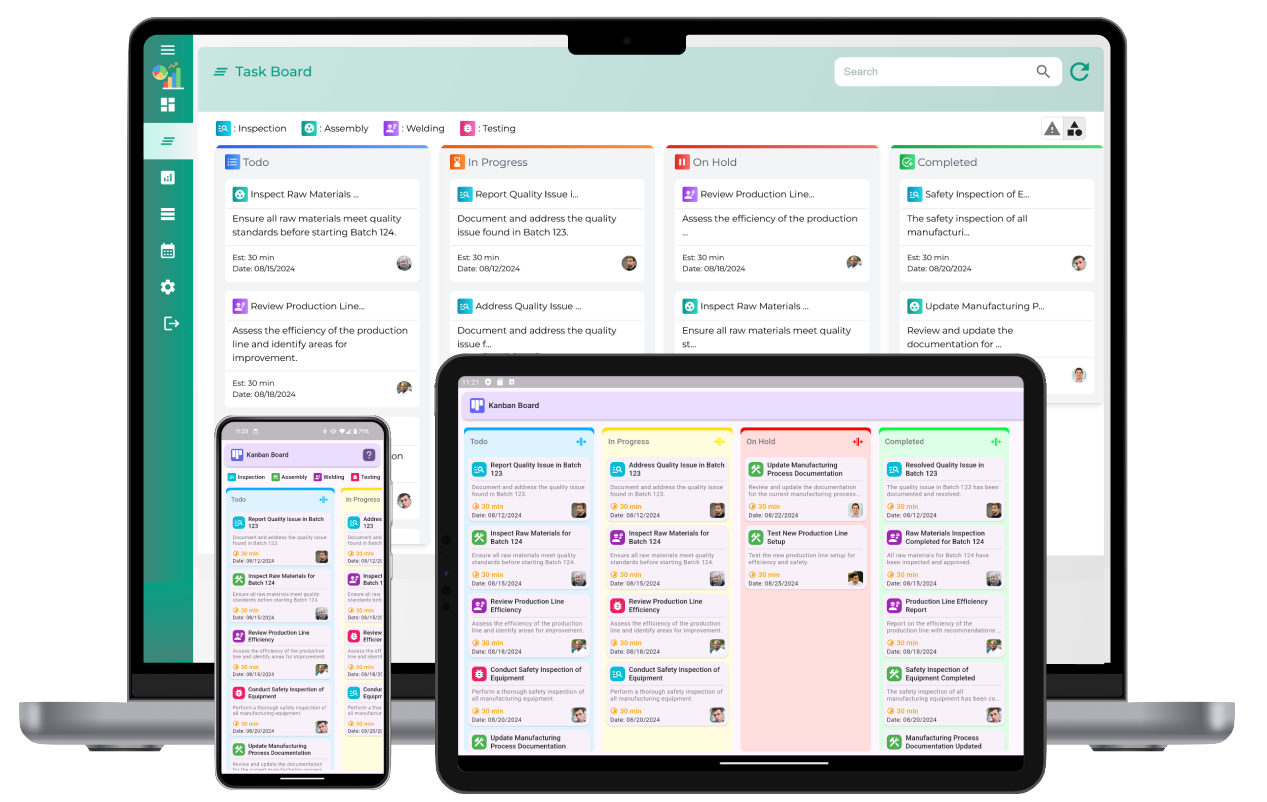Kanban is a powerful tool for implementing Lean Manufacturing principles, helping businesses streamline production processes, reduce waste, and enhance efficiency. By visually managing workflow and limiting work-in-progress, Kanban ensures a continuous flow of materials and tasks while improving overall productivity.

1. Understanding the Kanban System in Lean Manufacturing
Kanban, meaning "visual signal" in Japanese, is a system designed to control inventory and production flow based on real-time demand. It operates on the pull system principle, ensuring that materials and tasks move through the production process only when needed, eliminating excess inventory and waste.
Key Principles of Kanban:
- Visualizing Work: Uses cards, boards, or digital tools to display tasks and inventory.
- Work-in-Progress (WIP) Limits: Controls the number of tasks in progress to prevent overload.
- Pull-Based Workflow: Ensures production is driven by actual demand rather than forecasts.
- Continuous Improvement: Regularly optimizes workflow by identifying inefficiencies.
2. Benefits of Implementing Kanban in Manufacturing
Implementing a Kanban system offers several advantages:
- Reduced Waste: Minimizes excess inventory, overproduction, and idle time.
- Improved Efficiency: Streamlines production processes for faster lead times.
- Better Inventory Control: Ensures optimal stock levels to avoid shortages or excess.
- Enhanced Flexibility: Adapts quickly to changes in demand.
- Increased Transparency: Provides real-time visibility into production workflow.
3. How to Set Up a Kanban System for Lean Manufacturing
Step 1: Identify Workflow Stages
Analyze your current production process and define key workflow stages. Common stages in a manufacturing Kanban system include:
- Raw Materials: Inventory of materials needed for production.
- Work-in-Progress (WIP): Tasks currently being processed.
- Quality Control: Inspection and validation of completed tasks.
- Finished Goods: Products ready for shipment.
Step 2: Establish Work-in-Progress (WIP) Limits
Define WIP limits to prevent bottlenecks and ensure smooth workflow. For example, if a workstation can handle five tasks at a time, restricting WIP to five prevents overloading.
Step 3: Create a Kanban Board
Develop a visual Kanban board to represent workflow stages. The board can be physical (with cards and columns) or digital. Each task or inventory movement is represented by a card, which moves through the stages as work progresses.
Step 4: Implement a Pull System
Ensure that production starts only when there is a demand signal. This prevents unnecessary stockpiling and aligns output with customer needs.
Step 5: Monitor and Optimize
Regularly review the Kanban system to identify inefficiencies. Use performance data to refine processes, adjust WIP limits, and eliminate bottlenecks.
4. Common Challenges in Kanban Implementation
- Resistance to Change: Employees may require training to adapt to the new system.
- Incorrect WIP Limits: Setting limits too high or too low can disrupt workflow.
- Overcomplication: Too many workflow stages may cause confusion.
- Lack of Continuous Monitoring: Without regular reviews, inefficiencies may persist.
5. The Future of Kanban in Lean Manufacturing
Advancements in automation and digital tools are enhancing Kanban systems. Real-time analytics, AI-driven process optimization, and automated inventory tracking are transforming traditional Kanban into a more intelligent, efficient system.
By implementing a well-structured Kanban system, manufacturers can achieve greater efficiency, reduce waste, and create a leaner, more agile production process.
How to Set Up a Kanban System for Lean Manufacturing
What is a Kanban system in lean manufacturing?
A Kanban system is a visual workflow management method used in lean manufacturing to optimize production and minimize waste.
How does a Kanban system support lean manufacturing principles?
Kanban supports lean principles by ensuring just-in-time production, reducing inventory waste, and improving process flow efficiency.
What are the key components of a Kanban system?
The key components include Kanban cards, signal boards, WIP limits, pull systems, and real-time tracking.
How do you set up a Kanban system for lean manufacturing?
To set up a Kanban system, define workflow stages, establish WIP limits, create Kanban cards, and implement a pull-based replenishment process.
What types of Kanban are used in manufacturing?
Types of Kanban include production Kanban, withdrawal Kanban, supplier Kanban, and emergency Kanban.
How does Kanban improve inventory management?
Kanban prevents overproduction by signaling demand-based replenishment, reducing excess inventory and associated costs.
What are the benefits of implementing a Kanban system?
Kanban improves efficiency, enhances workflow visibility, reduces waste, and increases production flexibility.
How do Kanban cards function in a lean manufacturing environment?
Kanban cards act as signals to trigger material movement, ensuring a smooth flow of resources and avoiding overproduction.
What role does WIP (Work-in-Progress) limit play in Kanban?
WIP limits restrict the number of tasks in progress, ensuring a balanced workflow and preventing bottlenecks.
How can a Kanban system reduce waste in manufacturing?
Kanban eliminates overproduction, reduces idle time, and minimizes excess inventory, leading to waste reduction.
What are the challenges of implementing a Kanban system?
Challenges include resistance to change, improper WIP limit setting, and the need for ongoing monitoring and adjustments.
How do you measure the success of a Kanban system?
Success is measured using metrics such as cycle time, lead time, production efficiency, and defect rates.
How does Kanban integrate with other lean tools?
Kanban integrates with lean tools such as 5S, Kaizen, and value stream mapping to enhance continuous improvement efforts.
How often should a Kanban system be reviewed and updated?
A Kanban system should be reviewed regularly, with adjustments based on performance metrics and operational needs.
What are best practices for sustaining a Kanban system?
Best practices include continuous training, regular performance analysis, and fostering a culture of continuous improvement.